Does this front garden look kinda familiar? I mean, it could be anywhere, and it could belong to anyone. Right? Which is why I love what this homeowner did with it – they made it their own. Inspired by Japanese water garden design, this front garden incorporates many elements of Japanese gardens, including a tsukubai, a Japanese bamboo fountain, a traditional lantern, Japanese garden ornaments, and a suikinkutsu (though I can’t be totally sure about that one… you’ll see why below).
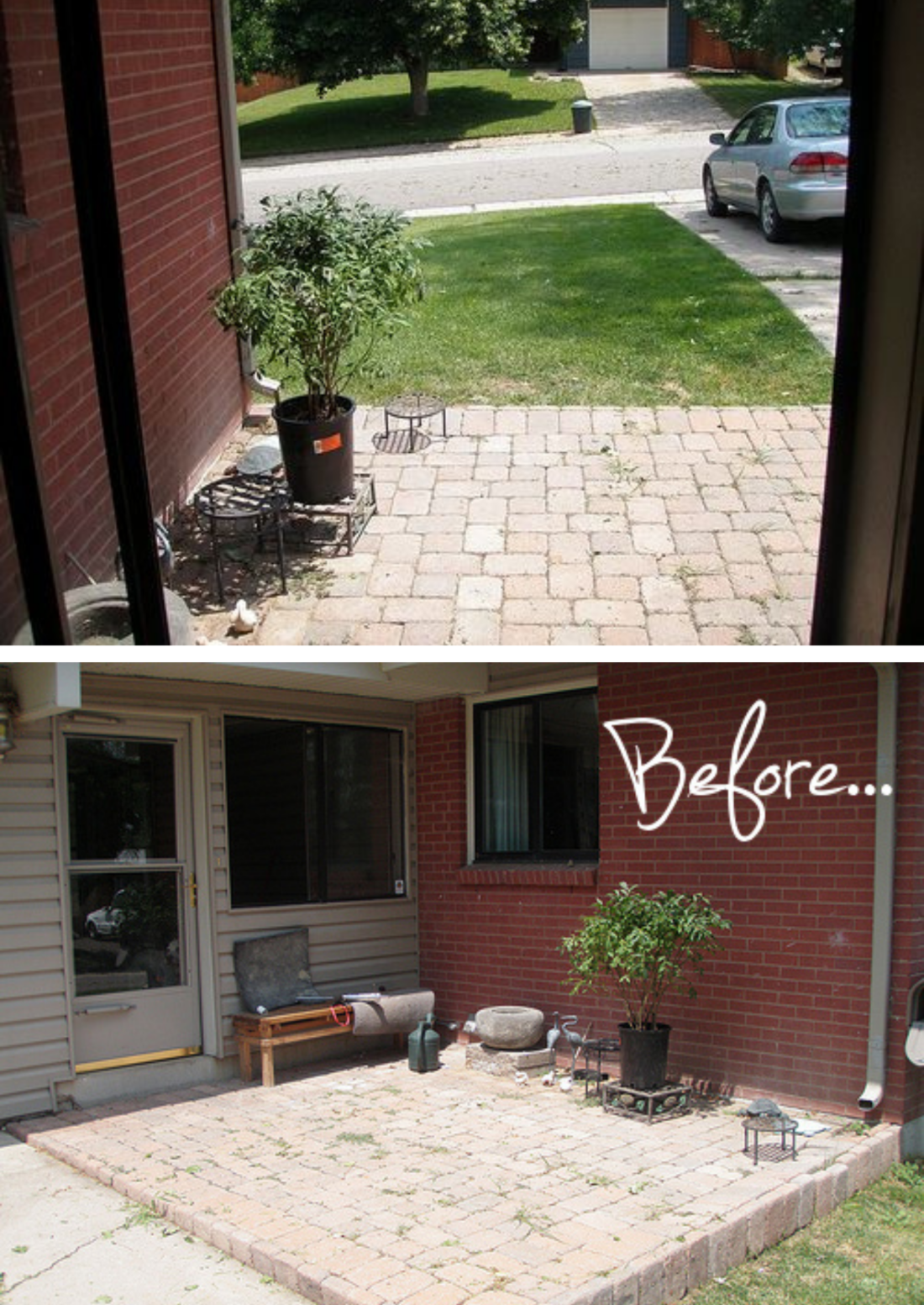
This inviting space is a tsukubai (蹲踞?) garden. A tsukubai is a small basin provided in Japanese Buddhist temples for visitors to purify themselves by the ritual washing of hands and rinsing of the mouth. I love the idea of putting one at the entry to the home as if to signify the entry into your own private temple retreat. Plus, this makeover really improved the curb appeal of this house. You can see the tsukubai in the back left. It is situated under a Japanese bamboo water fountain.
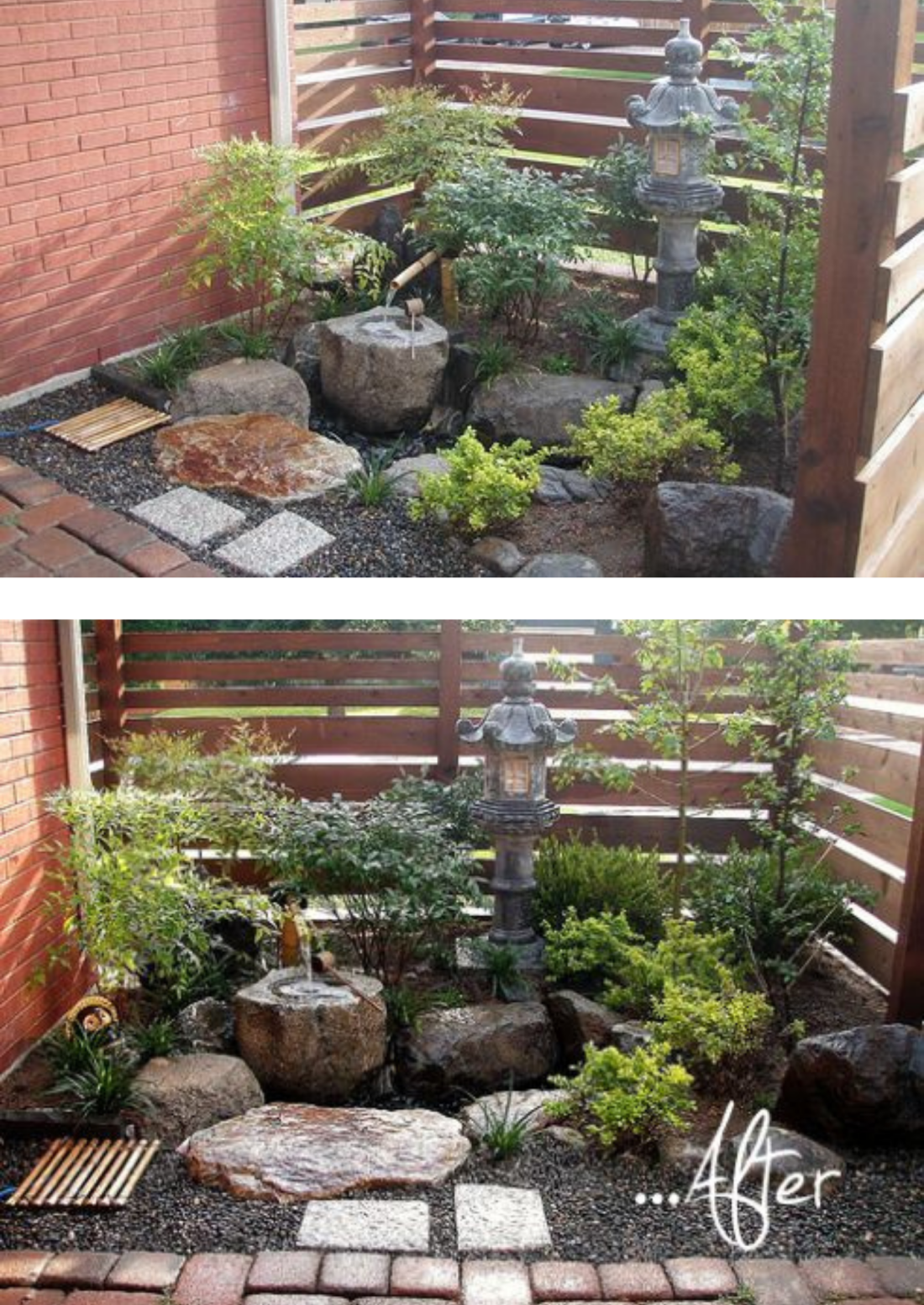
What is a Tsukubai garden?
Tsukubai gardens incorporate elements of Zen philosophy and create a tranquil and contemplative atmosphere. These are the main elements in a Tsukubai garden:
Tsukubai Basin
The central feature of a Tsukubai garden is the stone basin, known as the tsukubai. It is usually made of stone and has a shallow basin for water. The tsukubai is used for ritual cleansing and symbolizes purification of the mind and spirit. Often a small water scoop, laid across the top, is ready for use. A supply of water is provided via a bamboo pipe called a kakei and this is what makes a japanese water fountain.
Water Source:
A supply of water is provided via a bamboo pipe called a kakei. The kakei, sits above the tsukubai basin. Water trickles down from the spout into the basin, providing a soothing and calming sound. The water source can be natural or recirculated using a small pump. I can’t tell if this garden also incorprates a suikinkutsu. (also known as a water harp). I’ve put a full description of what a suikinkutsu is below. I’m fascinated with these musical upside down fountains.
Stone Pathways
Stone pathways are common in Tsukubai gardens and they guide visitors through the space. Flat stepping stones or irregularly shaped stones arranged in a harmonious and aesthetic manner create functional paths.
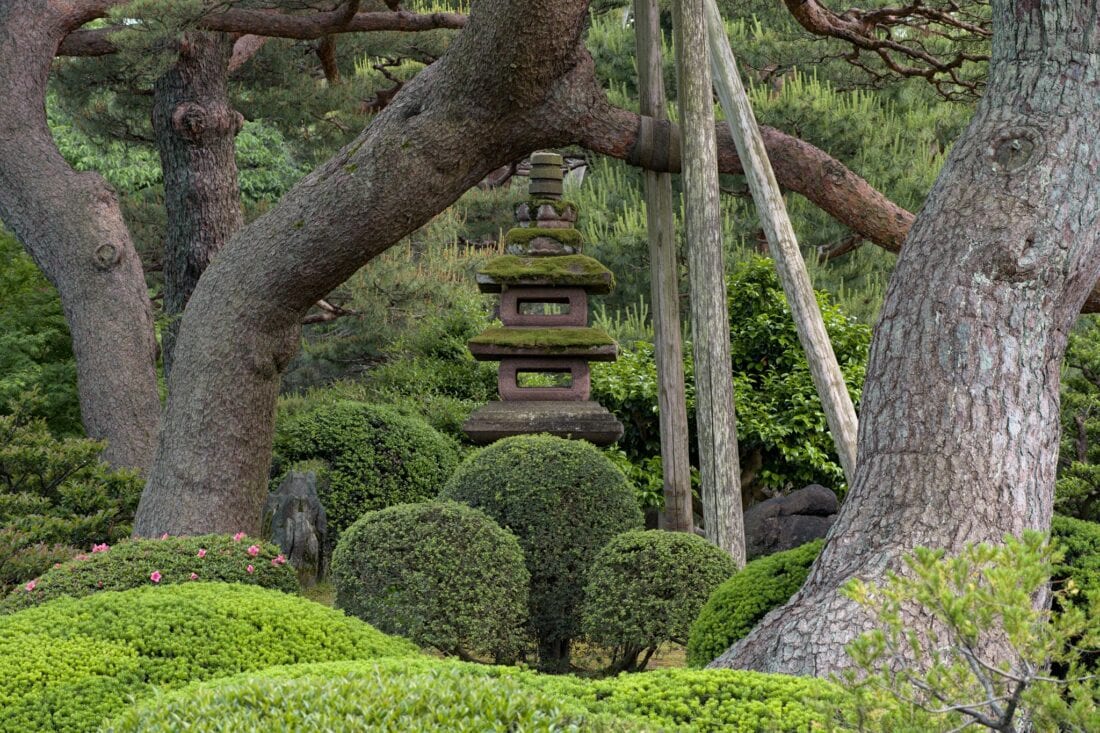
Garden Lanterns
Use traditional Japanese lanterns, such as stone lanterns (ishidoro) or hanging lanterns (andon). Often made if stone of metal, these lanterns add an element of beauty and serve as decorative focal points. Light it in the evening to create a magical ambiance.
Moss and Gravel
Tsukubai gardens often feature a ground cover of moss, which adds a lush and serene appearance. Moss symbolizes age and longevity in Japanese culture. Gravel or pebbles create contrasting textures and to represent flowing water or ripples around the tsukubai basin.
Zen Garden Elements
Some Tsukubai gardens incorporate elements of Zen gardens, such as raked gravel or sand to create abstract patterns representing water or waves.
Surrounding Vegetation
The choice and arrangement of plants in a Tsukubai garden are simple and minimalistic. Evergreen shrubs, bamboo, and other carefully selected plants create a backdrop and frame the space, providing a sense of enclosure and privacy.
Seating Areas
Some Tsukubai gardens include seating areas where visitors can sit and contemplate the peaceful surroundings. Place stone benches or simple wooden stools to strategically offer a view of the tsukubai and the rest of the garden.
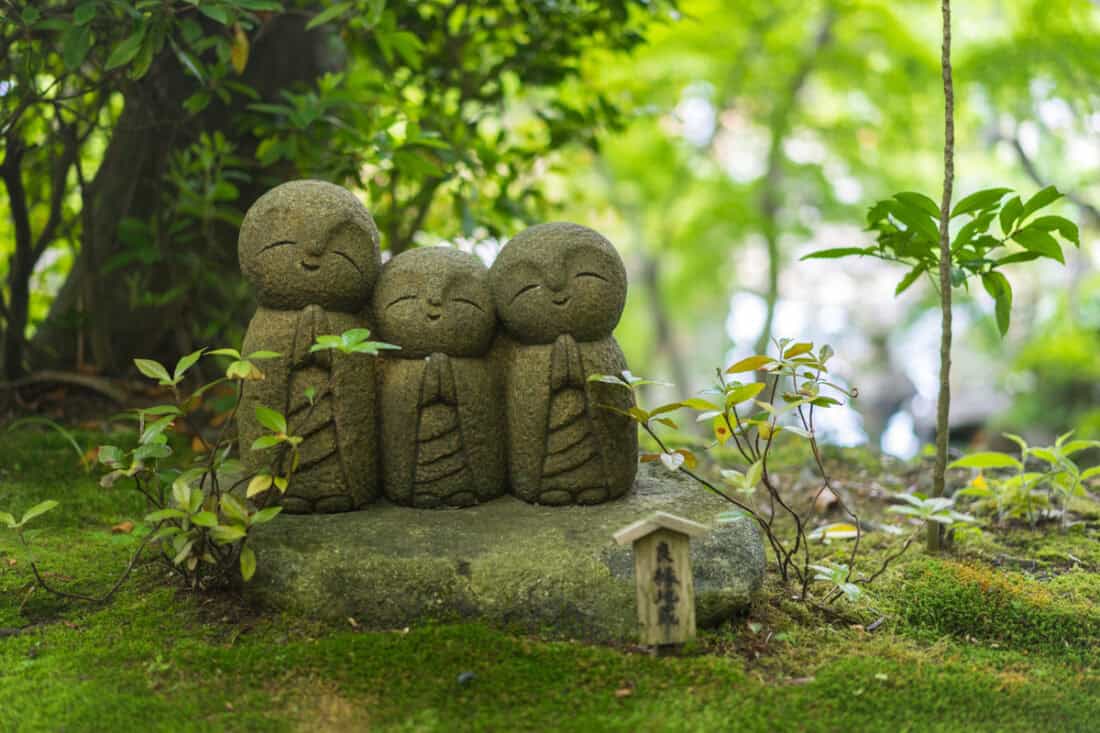
Symbolic Stones and Ornaments
Place symbolic stones or ornaments, such as large rocks, stone pagodas, or miniature figurines, in the garden. These elements can represent natural features, deities, or philosophical concepts, adding depth and meaning to the overall design.
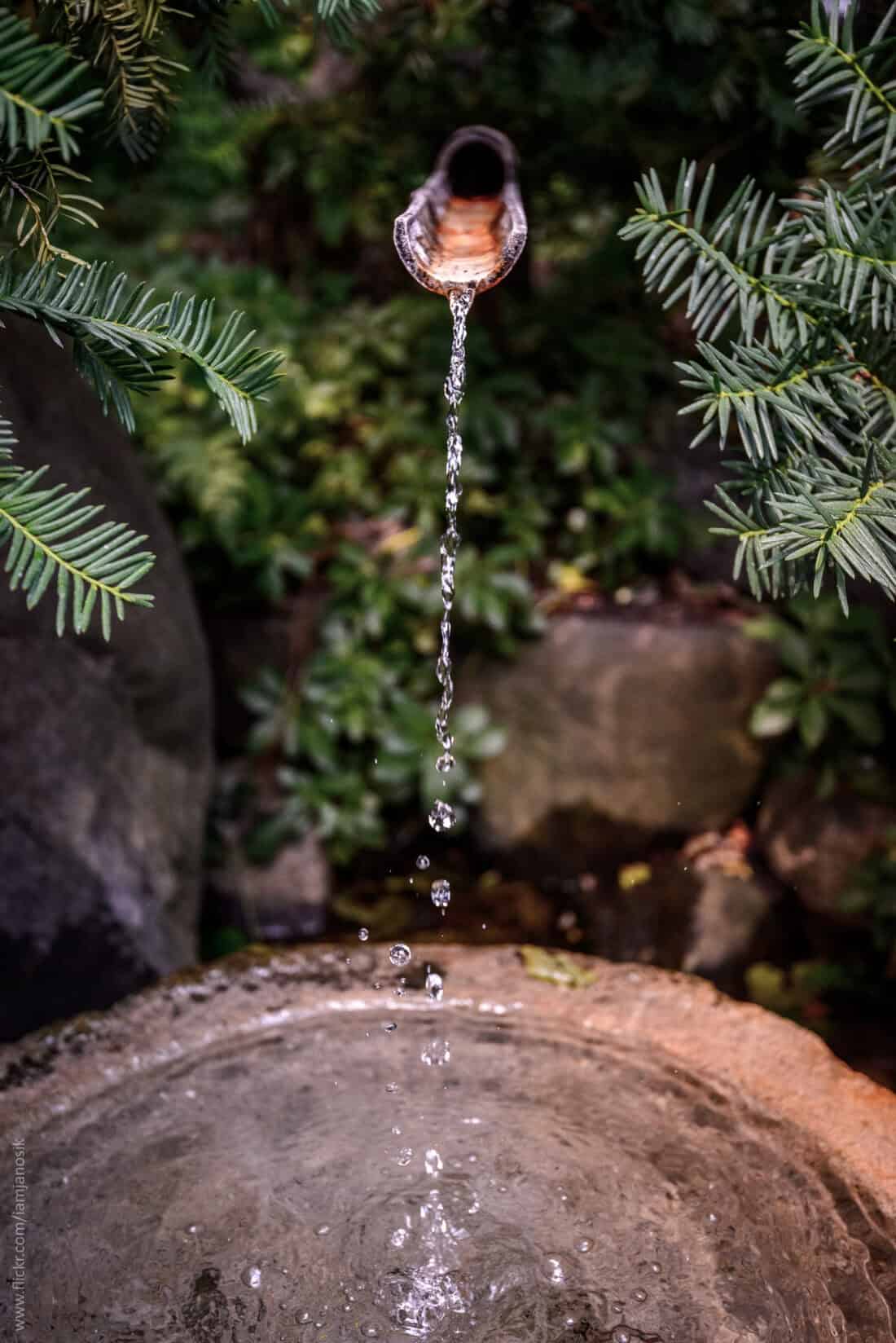
The Tsukubai Water Basin Front Garden
I’m amazed how all the essential elements fit so perfectly – even in this small front garden. The most important part of this type of design is to maintain harmony, simplicity, and a sense of tranquility, reflecting the principles of Japanese aesthetics and Zen philosophy.
Traditionally, a Tsukubai water garden is not specifically meant for entryways. But when the placement of a Tsukubai garden is near the entryway it can create a welcoming and serene atmosphere for visitors as they cleanse their hands and purify their minds before entering.
In Japanese tea ceremonies, a Tsukubai garden is commonly found in the “machiai” area. This an outdoor waiting area where participants gather before entering the tea house. It allows guests to perform the ritual cleansing before proceeding with the tea ceremony. This is a great example of adopting Japanese garden design ideas and making them entirely appropriate for a suburban home garden entrance.
What is a suikinkutsu?
A suikinkutsu is a traditional Japanese garden ornament that produces a unique musical sound (hence aka water harp). It consists of a buried ceramic pot or jar with a small hole at the top. It is typically found in Japanese tea gardens or other tranquil outdoor spaces. The suikinkutsu creates a gentle and resonating sound when water drips into it, producing a melodic tone that adds to the ambiance of the garden. (see the diagram below). It can be combined with other elements of japanese water gardens, like the bamboo fountain, and the stone tsukubai.
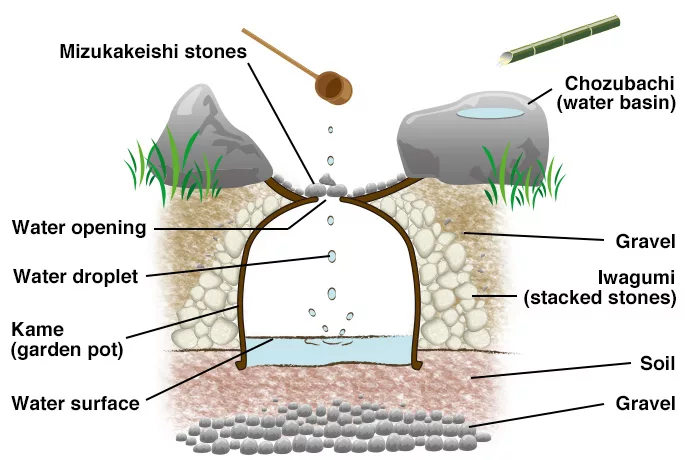
How a suikinkutsu works:
- Design and Placement: A suikinkutsu is in the ground, partially buried to create a resonating chamber. The pot is positioned so that the small hole at the top remains above the ground.
- Water Source: A water source, such as a bamboo pipe or a stone spout, sits above the suikinkutsu, usually near the surface of the ground. This water source continuously drips water into the hole of the pot.
- Resonating Sound: As the water drips into the buried pot, it resonates within the chamber, creating a distinct and musical sound. The pot acts as a resonator, amplifying and enriching the tones produced by the dripping water.
- Musical Ambiance: The suikinkutsu sound is soft, melodic, and reminiscent of the soothing tones of a koto or a harp. It adds a tranquil and meditative atmosphere to the garden, creating a harmonious backdrop for relaxation or contemplation.
Suikinkutsu can vary in size and design. Some gardens may have multiple suikinkutsu arranged at different locations to create a musical journey as visitors move through the space. You can change the sound of the suikinkutsu by changing the size and shape of the pot, the type and flow rate of the water, and the surrounding environment.

It’s important to note that the installation and maintenance of a suikinkutsu may require some expertise (as in you might need a professional specialist).
Where to Shop for Elements of a Japanese Water Garden:
It is always exciting to find an importer near where you live or to bring elements home from travels, but in the absence of that, here are some sources for japanese water garden supplies.
- Japanese stone Lantern (Toro) –
- Moon Pagoda Sculpture
- Pagoda Stone Lantern
- Water Ladle and Water ladle Rest from Japan
- Bamboo Fountain Kit to make any Vessel into a Tsukubai water fountain
Japanese garden design style is one of many different historical and cultural styles you might choose to build off of when creating your own garden. Learn more about Japanese design and all garden design by joining the PITH + VIGOR Garden Design Lab.
How to make a Suikinkutsu diagram from Traditional Kyoto. Garden images by justaninja
Love the garden. Dislike the fence.
It’s totally incongruent with the architecture in every aspect ; size of boards, height of extended posts and height of overall fence structure and coloration.
I love the Garden. I really love the light fixture. Nice work for a DIY project.
Love the courtyard. I even like the fence from the inside – the filtered light and privacy and lines are great inside. The color nicely matches the tone of the brick for light dark value, and yet adds a very natural element with a contrasting backlit horizontal line. From the outside, it’s sort of like a delivered crate. I do wonder what the fence looks like from the street, in the neighborhood. Maybe it wants a dogwood on the outside, or even a twisted pine, and some liriope. It looks fabulous so far, but every marvelous project has an edge of the finished part.
This project breaks some rules – it obscures the doorway, and crowds the driveway. Does it want a welcome sign next to the door, or something more subtle? But I applaud the homeowner who decided it was worth breaking rules to create a beautiful space. It would be lovely to walk through that garden daily.
I like the design and the fence. Maybe you could consider tying the house into the design by cladding the brick with horizontal cedar cladding. Front gardens are a lost opportunity. Your Japanese garden will delight residents and passersby.
I love it. It has given me hope for my front entry!
Thank You for the Insightful Guide on Tsukubai Gardens!
Your post on Tsukubai Japanese Water Fountain Gardens was inspiring! I loved learning about the stone basin, bamboo fountain, and suikinkutsu. Your insights on harmony and tranquility were invaluable. Thank you for sharing!